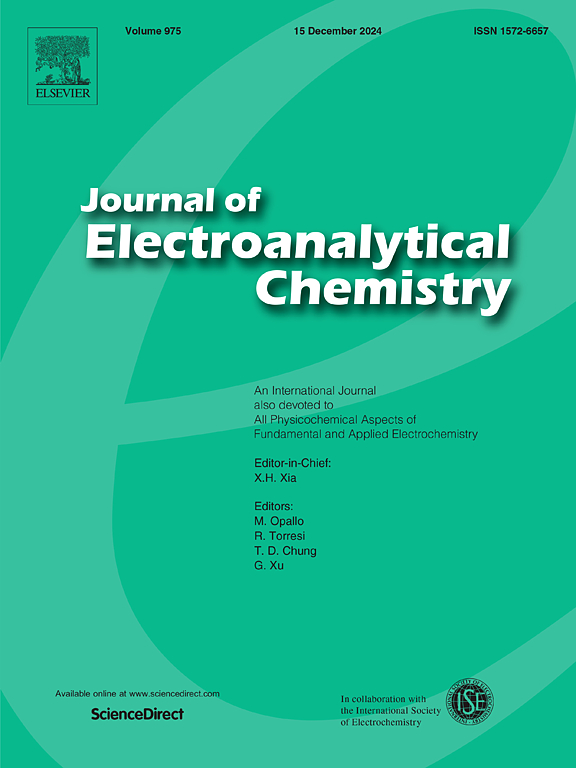EIS的广义相分析揭示了h端n-Si的电化学羟基化作用
IF 4.1
3区 化学
Q1 CHEMISTRY, ANALYTICAL
引用次数: 0
摘要
基于恒相元(CPE)的概念推广,定义了一组改进的分数阶函数来描述电阻抗仪测量的电化学界面中电荷的流动和积累。所谓的gpe方法有五个主要优点:(i)它是一种微分分析,可以检测细微的法拉第反应;(ii)当系统处于阻塞状态时,产生无色散界面电容;(iii)与广为接受的Brug表达式相比,它能更好地估计双电层电容;(iv)允许实时跟踪中等快速发展的系统;(v)无模型。通过分析无氟水电解质中阶梯阳极电位扫描作用下h端n-Si(100)电极在黑暗中的阻抗演变,可以证明gpe方法的深远益处。结果表明,该界面发生了涉及空穴、悬空键和电子的电化学羟基化反应。本文章由计算机程序翻译,如有差异,请以英文原文为准。

The electrochemical hydroxylation of H-terminated n-Si as revealed by a generalized phase analysis of EIS: Real time detection
Based on the conceptual generalization of a constant phase element (CPE) an improved set of fractional-order functions is defined to describe the flow and accumulation of charge in an electrochemical interface, as measured by EIS. The so-called gpe method has five major advantages: (i) it is a differential analysis, which enables the detection of subtle faradaic reactions; (ii) it generates a dispersionless interfacial capacitance whenever the system is in a blocking state; (iii) it gives a better estimate for the electric double layer capacitance than the widely accepted Brug's expression; (iv) it allows real-time tracking of a moderately fast evolving system; (v) it is model-free. The far-reaching benefits of the gpe method will be demonstrated by analyzing the impedance evolution of an H-terminated n-Si (100) electrode under the action of a staircase anodic potential scan in a fluoride-free aqueous electrolyte in the dark. It will be shown that this interface undergoes an electrochemical hydroxylation reaction involving a hole, a dangling bond and an electron.
求助全文
通过发布文献求助,成功后即可免费获取论文全文。
去求助
来源期刊
CiteScore
7.80
自引率
6.70%
发文量
912
审稿时长
2.4 months
期刊介绍:
The Journal of Electroanalytical Chemistry is the foremost international journal devoted to the interdisciplinary subject of electrochemistry in all its aspects, theoretical as well as applied.
Electrochemistry is a wide ranging area that is in a state of continuous evolution. Rather than compiling a long list of topics covered by the Journal, the editors would like to draw particular attention to the key issues of novelty, topicality and quality. Papers should present new and interesting electrochemical science in a way that is accessible to the reader. The presentation and discussion should be at a level that is consistent with the international status of the Journal. Reports describing the application of well-established techniques to problems that are essentially technical will not be accepted. Similarly, papers that report observations but fail to provide adequate interpretation will be rejected by the Editors. Papers dealing with technical electrochemistry should be submitted to other specialist journals unless the authors can show that their work provides substantially new insights into electrochemical processes.

 求助内容:
求助内容: 应助结果提醒方式:
应助结果提醒方式:


